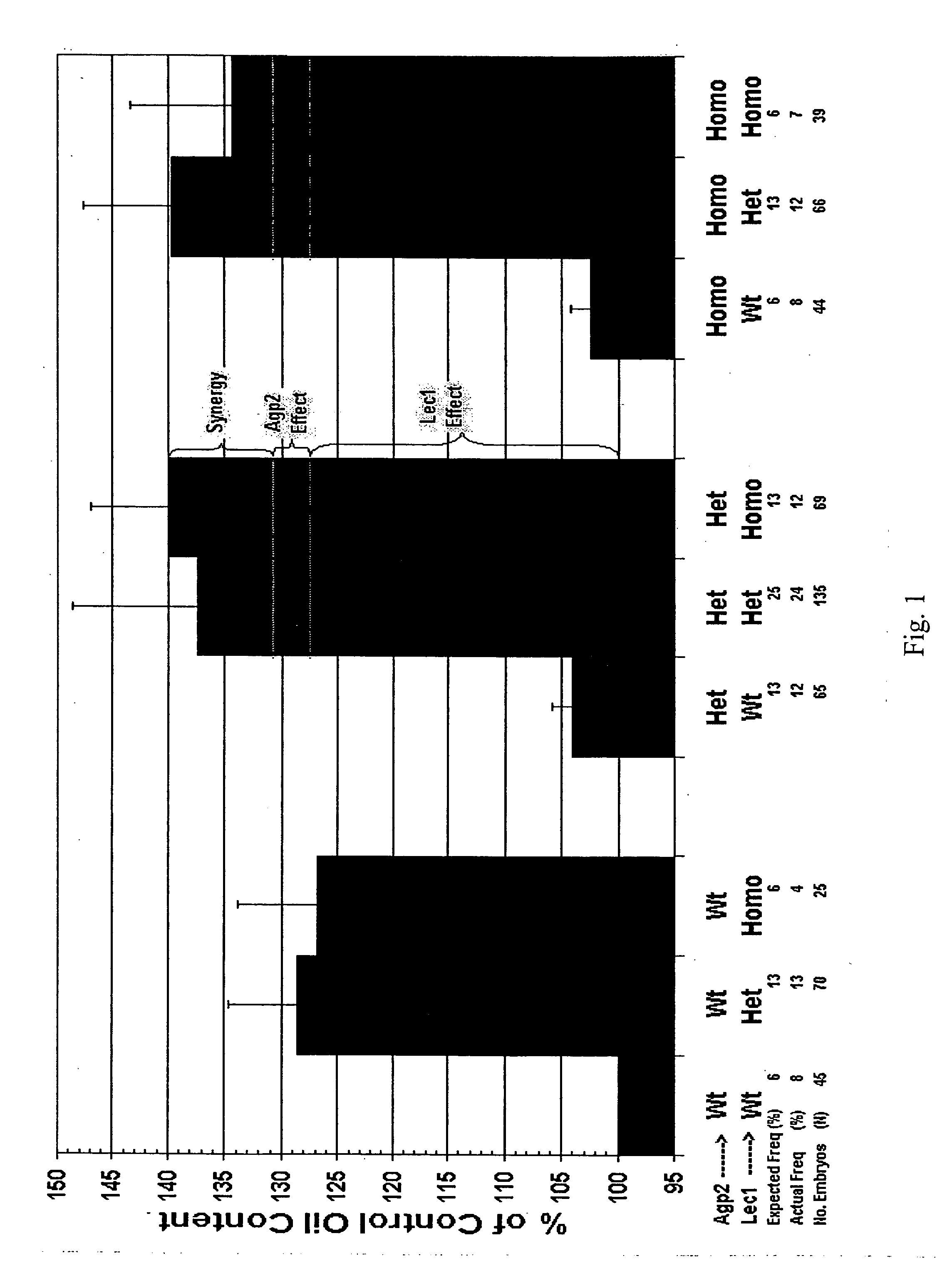Alteration of oil traits in plants
a technology of plant traits and oil, applied in the field of plant genetics and molecular biology, can solve the problems of increasing the burden on agriculturists to increase both agricultural output and productivity, slow traditional approaches, and limited natural variation or artificially induced mutations, so as to improve the level of desirable oils, improve the oil production and characteristics, and improve the effect of oil production
- Summary
- Abstract
- Description
- Claims
- Application Information
AI Technical Summary
Benefits of technology
Problems solved by technology
Method used
Image
Examples
example 1
Generation of High Oil Content Seed via Simultaneous Expression of LEC1 and Suppression of AGP2
[0195] F1 kernels from a single ear that, per se, all contained the LEC1 transgene (SEQ ID NO:1, encoding SEQ ID NO:2) and also segregated 1:1 for the AGP2 transgene (SEQ ID NO:5, encoding truncated AGP2 amino acid sequence of SEQ ID NO:6), were planted. The seed represented the cross of a single AGP2 event (i.e., AGP2-cosuppression) with a single LEC1 event (i.e., LEC1 expression). The pedigree and per se segregation pattern indicated that all kernels were heterozygous for the LEC1 transgene and half were also heterozygous for the AGP2 transgene. Ten plants containing LEC1 alone and ten plants having both transgenes were self-pollinated. Upon analyzing 24 mature embryos from each ear for embryo oil level, the presence of both genes was more favorable for increasing oil concentration than LEC1 alone. Three F1 plants that were heterozygous for both AGP2 and LEC1 transgenes were self-pollin...
example 2
Cloning of ADP-Glucose Pyrophosphorylase Gene (AGP), Construction of Expression Vectors, and Transformation and Regeneration of Plants
[0201] A full-length cDNA clone corresponding to the AGP1 subunit of the embryo isoform of ADP-glucose pyrophosphorylase (Giroux et al. (1995) Plant Physiol., 108: 1333-1334; incorporated herein in its entirety by reference) is obtained using the polymerase chain reaction (PCR). A template is prepared by generating first strand cDNA from total RNA isolated from 16 day-old maize kernels. Primers are designed based upon the published sequence of AGP1. These primers are used in a PCR reaction to amplify the AGP1 cDNA by conventional methods. The resulting PCR product is purified and subcloned into the vector pCRII (Invitrogen) and sequenced on both strands to confirm its identity. This clone is designated p9734. An embryo-specific expression cassette is constructed by digesting p9734 with EcoRI, treating with Klenow enzyme to generate blunt ends, and th...
example 3
Cloning of LEC1. Construction of Expression Vectors and Transformation and Regeneration of Plants
[0217] Immature maize embryos from greenhouse or field grown High type II donor plants are bombarded with a plasmid containing a LEC1-encoding polynucleotide (FIG. 8). The LEC1-encoding polynucleotide is operably linked to the Ltp2 promoter and downstream to a PINII terminator, and a second LEC1-encoding sequence is operably linked to the G(amma)Z(ein)-W64A promoter and a downstream GZ-W64A terminator. The plasmid comprises the selectable marker gene PAT (Wohlleben et al. (1988) Gene 70: 25-37), which confers resistance to the herbicide Bialaphos. Alternatively, the selectable marker gene is provided on a separate plasmid. Transformation is performed as follows. Media recipes follow below.
[0218] The ears are husked and surface sterilized in 30% Clorox bleach plus 0.5% Micro detergent for 20 minutes, and rinsed two times with sterile water. The immature embryos are excised and placed em...
PUM
| Property | Measurement | Unit |
|---|---|---|
| diameter | aaaaa | aaaaa |
| pressures | aaaaa | aaaaa |
| pressures | aaaaa | aaaaa |
Abstract
Description
Claims
Application Information
 Login to View More
Login to View More - R&D
- Intellectual Property
- Life Sciences
- Materials
- Tech Scout
- Unparalleled Data Quality
- Higher Quality Content
- 60% Fewer Hallucinations
Browse by: Latest US Patents, China's latest patents, Technical Efficacy Thesaurus, Application Domain, Technology Topic, Popular Technical Reports.
© 2025 PatSnap. All rights reserved.Legal|Privacy policy|Modern Slavery Act Transparency Statement|Sitemap|About US| Contact US: help@patsnap.com



